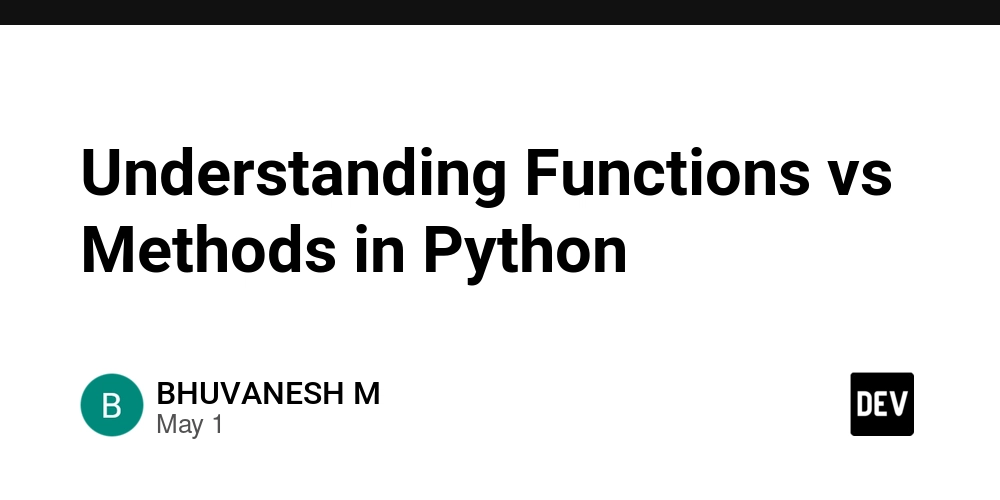Understanding Functions vs Methods in Python
In Python, functions and methods are both essential tools for performing operations, but they serve different purposes. Understanding the key distinctions between them is crucial for writing clean and efficient Python code. Let’s explore these concepts in detail. 1. Functions: A function is a block of reusable code designed to perform a specific task. Unlike methods, functions are not tied to any particular object or data structure. Functions are defined globally and can be called anywhere in your program, without the need for an object to invoke them. Functions are independent and can work with any kind of data passed to them as arguments. Example of a function: sorted() numbers = [3, 1, 4, 1, 5, 9] sorted_numbers = sorted(numbers) print(sorted_numbers) # Output: [1, 1, 3, 4, 5, 9] The sorted() function is a built-in function in Python. It accepts any iterable (list, tuple, string, etc.) and returns a new sorted list. It does not modify the original list, which makes it non-mutating. Key Takeaways: Functions in Python can operate globally. They do not belong to a specific object or class. A function can return a new value, leaving the original data unchanged. 2. Methods: A method is a function that is associated with an object. In Python, methods are always invoked on an instance of a class, making them object-oriented. Methods are called using dot notation: object.method(). Methods are tied directly to a specific data structure (e.g., lists, dictionaries, etc.) and operate on that data. Example of a method: sort() numbers = [3, 1, 4, 1, 5, 9] numbers.sort() # Sorts the list in place print(numbers) # Output: [1, 1, 3, 4, 5, 9] The sort() method is a method available for list objects. Unlike sorted(), it modifies the list in place (it does not return a new list). The list object itself is changed when sort() is called, which makes it mutating. Key Takeaways: Methods are called on objects (or instances of classes). They are typically used to manipulate or perform operations on the object they belong to. Methods often modify the object in place, unlike functions which tend to return a modified copy. Key Differences Between Functions and Methods Feature sorted() (Function) sort() (Method) Type Function Method Used on Any iterable (list, tuple, string, etc.) Only lists Modifies the object? No, it returns a new sorted object Yes, it sorts the list in place Syntax sorted(iterable, key=None, reverse=False) list.sort(key=None, reverse=False) Return value Returns a new sorted iterable Returns None (modifies the list in place) Why Should You Care? As you write more Python code, understanding when to use a function versus a method is crucial. Here’s why: Function: You might prefer functions when you need to work with multiple types of data or when you want a clean, functional approach. Functions provide flexibility and reuse across different data structures. Method: Methods are ideal for object-oriented programming when you’re working with specific objects and need to modify their internal state. They offer more control over the data they operate on, and they can make your code more intuitive when working within a class. Real-World Scenario: Sorting Data Let's say you're working with a dataset of user records and need to sort the users by their names: If the dataset is a list of dictionaries, you might use sorted() to create a sorted list based on a specific key (e.g., name). If you're working directly with a list of names, sort() would be perfect to in-place modify the list without creating a new one. Final Thoughts: Use functions like sorted() when you need to operate on a variety of data structures without altering the original. Use methods like sort() when you’re working with data structures like lists and you want to perform operations directly on them. By understanding the subtle differences between functions and methods, you’ll be able to choose the right tool for each task, leading to cleaner and more efficient Python code.

In Python, functions and methods are both essential tools for performing operations, but they serve different purposes. Understanding the key distinctions between them is crucial for writing clean and efficient Python code. Let’s explore these concepts in detail.
1. Functions:
A function is a block of reusable code designed to perform a specific task. Unlike methods, functions are not tied to any particular object or data structure.
- Functions are defined globally and can be called anywhere in your program, without the need for an object to invoke them.
- Functions are independent and can work with any kind of data passed to them as arguments.
Example of a function: sorted()
numbers = [3, 1, 4, 1, 5, 9]
sorted_numbers = sorted(numbers)
print(sorted_numbers) # Output: [1, 1, 3, 4, 5, 9]
- The
sorted()function is a built-in function in Python. It accepts any iterable (list, tuple, string, etc.) and returns a new sorted list. - It does not modify the original list, which makes it non-mutating.
Key Takeaways:
- Functions in Python can operate globally.
- They do not belong to a specific object or class.
- A function can return a new value, leaving the original data unchanged.
2. Methods:
A method is a function that is associated with an object. In Python, methods are always invoked on an instance of a class, making them object-oriented.
- Methods are called using dot notation:
object.method(). - Methods are tied directly to a specific data structure (e.g., lists, dictionaries, etc.) and operate on that data.
Example of a method: sort()
numbers = [3, 1, 4, 1, 5, 9]
numbers.sort() # Sorts the list in place
print(numbers) # Output: [1, 1, 3, 4, 5, 9]
- The
sort()method is a method available for list objects. Unlikesorted(), it modifies the list in place (it does not return a new list). - The list object itself is changed when
sort()is called, which makes it mutating.
Key Takeaways:
- Methods are called on objects (or instances of classes).
- They are typically used to manipulate or perform operations on the object they belong to.
- Methods often modify the object in place, unlike functions which tend to return a modified copy.
Key Differences Between Functions and Methods
| Feature |
sorted() (Function) |
sort() (Method) |
|---|---|---|
| Type | Function | Method |
| Used on | Any iterable (list, tuple, string, etc.) | Only lists |
| Modifies the object? | No, it returns a new sorted object | Yes, it sorts the list in place |
| Syntax | sorted(iterable, key=None, reverse=False) |
list.sort(key=None, reverse=False) |
| Return value | Returns a new sorted iterable | Returns None (modifies the list in place) |
Why Should You Care?
As you write more Python code, understanding when to use a function versus a method is crucial. Here’s why:
- Function: You might prefer functions when you need to work with multiple types of data or when you want a clean, functional approach. Functions provide flexibility and reuse across different data structures.
- Method: Methods are ideal for object-oriented programming when you’re working with specific objects and need to modify their internal state. They offer more control over the data they operate on, and they can make your code more intuitive when working within a class.
Real-World Scenario: Sorting Data
Let's say you're working with a dataset of user records and need to sort the users by their names:
- If the dataset is a list of dictionaries, you might use
sorted()to create a sorted list based on a specific key (e.g., name). - If you're working directly with a list of names,
sort()would be perfect to in-place modify the list without creating a new one.
Final Thoughts:
- Use functions like
sorted()when you need to operate on a variety of data structures without altering the original. - Use methods like
sort()when you’re working with data structures like lists and you want to perform operations directly on them.
By understanding the subtle differences between functions and methods, you’ll be able to choose the right tool for each task, leading to cleaner and more efficient Python code.






































































































































































![[The AI Show Episode 145]: OpenAI Releases o3 and o4-mini, AI Is Causing “Quiet Layoffs,” Executive Order on Youth AI Education & GPT-4o’s Controversial Update](https://www.marketingaiinstitute.com/hubfs/ep%20145%20cover.png)









































































































































































































































































_Inge_Johnsson-Alamy.jpg?width=1280&auto=webp&quality=80&disable=upscale#)















































































































![Under-Display Face ID Coming to iPhone 18 Pro and Pro Max [Rumor]](https://www.iclarified.com/images/news/97215/97215/97215-640.jpg)
![New Powerbeats Pro 2 Wireless Earbuds On Sale for $199.95 [Lowest Price Ever]](https://www.iclarified.com/images/news/97217/97217/97217-640.jpg)
![Alleged iPhone 17-19 Roadmap Leaked: Foldables and Spring Launches Ahead [Kuo]](https://www.iclarified.com/images/news/97214/97214/97214-640.jpg)





































































































